Posted by Elena del Valle on February 13, 2012

CNN en espanol news staff covering 2012 presidential debates
Photos: CNNenEspanol, Stagnito Media
The changes in media that deepened with the Great Recession and the demise of the traditional profit model will continue; social media and citizen journalism will likely impact media; and media channels are expected to further evolve in 2012, likely merging digital and social media into the mix, and continuing the development of media hybrids, according to a recently released Vocus report.
Vocus analysts believe that last year media experienced “an evolutionary revival.” While more newspapers closed last year (152) than the previous year (151) and hundreds of staff were left jobless there were 201 launches, 158 online and 43 in print. The new channels, many of them focused on local happenings, are likely to be home to young and digitally savvy staff.
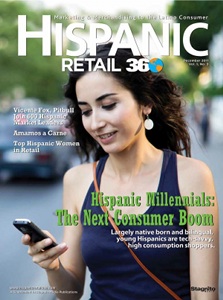
Hispanic Retail 360 December 2011 cover
The effect of the economic downturn was milder on magazines than on papers last year although there were very few national print magazine launches. Lucky Peach, Hispanic Retail 360 and The Social Media Monthly were cited in the report. Executives of Hispanic Retail 360, launched April 2011 by Stagnito Media as a continuation of the company’s annual conference by the same name, plan to publish four issues in 2012. The 36-page magazine, edited by Don Longo and produced by four staff, is divided into 60 percent editorial and 40 percent ads. It sells for $50 per year.
At the same time 50 new online only magazines began publishing in 2011. While many worried that the iPad would signal the end of magazines the report speculates the device may be saving magazines because people are looking for digital content to read on their tablets.
In 2011, streaming of television programs online was growing and there was growth in television and television related websites for Hispanics, according to the report. Several major TV networks launched websites targeting the Spanish dominant Hispanic population. CNN launched CNNenEspanol. com and Fox News launched Fox News Latino. NBC may launch NBCLatino.com this year.
Last year, News Corp., Fox’s parent company, launched Fox Hispanic Media, which encompasses Fox Deportes, Utillisima and Nat Geo Mundo, a Spanish-language National Geographic channel. NBC established Hispanic at NBC, an integrated sales/marketing division and research platform called.

Don Longo, editor, Hispanic Retail 360
The Spanish dominant market has been targeted by some local news sites. For example, the El Paso Times offers SomosFrontera.com; Patch.com offers Latino oriented editions in Southern California. Online Hulu launched Hulu Latino with Spanish language soap operas and other programs from Univision, Estrella TV, Galavision, Azteca America, and Telefutura (see Hulu targets U.S. Spanish speakers ). Overall, the researchers estimate there will be strong competition between television and other news sources online.
There was an increase of 240 million radio listeners 12 and older in 2011. Online radio use increased and the favorite format seems to be, if last year is any indication, news and talk shows, according to the report.
Blogs and bloggers have found acceptance and in some cases popular followings. Last year’s growth in blogs was mainly in the consumer sector, especially blogs about domestic life, parenting and cooking as well as professionals and companies, according to the report.
The State of the Media Report 2012 Evolving and Merging, an 18-page report, was compiled and written by Katrina M. Mendolera of Vocus, a provider of cloud-based marketing and public relations software. The report was the third annual State of the Media Report produced by the Vocus Media Research Team who predict that in 2012, cultivation and implementation will continue along with new ideas and trends. Print and broadcast will be enhanced into “shinier, newfangled versions that now incorporate all the elements of new and social media.”
Posted by Elena del Valle on February 10, 2012
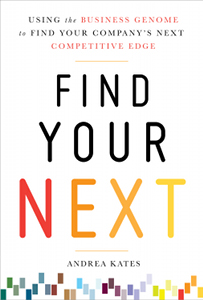
Find Your Next book cover
Photos: Andrea Kates
Andrea Kates, a branding specialist, believes many businesses share a similar “genetic” structure. She is convinced that by understanding what works for a company’s “genetic” type it is possible to fine tune that company focusing on strengths and avoiding weaknesses. In Find Your Next: Using the Business Genome to Find Your Company’s Next Competitive Edge (McGraw Hill, $30), a 226-page hardcover book published this year, she outlines the method and steps she proposes to unlock a company’s basic structure in order to focus on the fine tuning.
She believes there are six main parts to a business: product and service innovation; customer impact; talent, leadership, and culture; process design; trendability and secret sauce. Part of the research she conducted for the book consisted of in-depth interviews with representatives of P.F. Chang’s, GE ecomagination, GM/OnStar, IndieGoGo, Placecast, Autodesk, Cisco Systems, and Jones Lang LaSalle.

Andrea Kates, author, Find Your Next
Kates fours steps are meant to combine experience and instinct. They are: sort through options and evaluate hunches; compare your business structure (she calls it genome) with existing successful businesses in your field; adopt the ideas of others you think will enhance your company; and release habits that are no longer useful and adopt those that can help your business grow.
Kates, according to her book bio, has worked as a business strategist, facilitator, and speaker, with 250 business innovation initiatives for corporations, entrepreneurs, and organizations including Royal Dutch Shell (Asia-Pacific), Audi, Allstate, Continental Airlines, Hewlett-Packard, JP Morgan Chase, KPMG, the Houston Texans (NFL), and OnStar.
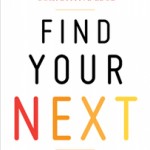
Click to buy Find Your Next
Comments:
Filed Under: Books
Posted by Elena del Valle on February 8, 2012

Nelson Albareda, president and CEO, NLB
Photo: Event US Live
Last month, National Latino Broadcasting, LLC (NLB) launched En Vivo, a music channel targeting United States Hispanics 18 to 49 years of age with a mix of hits and live performances; and Cristina, a talk show centered channel relying on the well known television gabber, part of a two-channel deal with Sirius XM Radio.
En Vivo, airing on SiriusXM channel 147, is expected to feature Tu Mañana Live, a bilingual morning talk show; The Mash Up, an English and Spanish language contemporary music program; Concierto En Vivo, offering concerts from around the world; and Club En Vivo with live broadcasts from some of the nation’s best clubs.
“We are convinced that En Vivo will become a favorite for Hispanics and non-Hispanics alike looking for a channel where Latin music is more than a preference; it is a lifestyle. The sheer diversity of genres within this music makes the programming possibilities truly exciting and our partnership with The Latin Recording Academy makes this endeavor unique and unprecedented,” said Nelson Albareda, president and chief executive officer, NLB.
Thanks to an exclusive deal with The Latin Recording Academy, according to promotional materials, En Vivo will become the official satellite radio part of the Latin Grammys. En Vivo plans to air daily content related to the Latin Grammy Awards and archival material.

Cristina Saralegui will have a one-hour show on the Cristina Channel
The En Vivo slogan is Donde Nace la Música (Where Music Is Born). The channel will broadcast from a new state-of-the-art facility in Miami and has secured partnerships with studios in New York and Los Angeles. These performance studios will allow live concerts to be broadcast as daily and weekly specials. Additional programming highlights include new music and a live recorded performance per hour.
The Cristina Channel with Cristina Saralegui will include a one-hour show with the talk show host targeting women 24 to 54 years old. NLB also plans to offer 24 hour daily programming on news, entertainment, music, and political issues on that channel.
National Latino Broadcasting, LLC (NLB), owned exclusively by Eventus, according to a spokesperson for Eventus is a media company targeting Latino communities in the United States through “entertaining and informative programming while creating innovative marketing solutions for marketers” targeting Latino consumers. The new channels will be promoted via a public relations campaign in English and Spanish.
SiriusXM, a satellite radio company, broadcasts 135 satellite radio channels of music, and sports, news, talk, entertainment, traffic, weather, and data services to 21 million subscribers.
Posted by Elena del Valle on February 6, 2012

Peter Winick, content strategist
Photo: Peter Winick
A podcast interview with Peter Winick, content strategist, Thought Leadership Leverage is available in the Podcast Section of Hispanic Marketing & Public Relations, HispanicMPR.com. During the podcast, Peter discusses thought leadership marketing with Elena del Valle, host of the HispanicMPR.com podcast.
Peter is a New York City based consultant who works with non-fiction authors and thought leaders. He has over twenty years of experience and has worked with a large number of bestselling authors and renowned thought leaders including Keith Ferrazzi, Chip Conley, Steve Shapiro, and Carol Roth. He has built and managed several consulting and professional development organizations. He can be found online at thoughtleadershipleverage.com
To listen to the interview, scroll down until you see “Podcast” on the right hand side, then select “HMPR Peter Winick” click on the play button below or download the MP3 file to your iPod or MP3 player to listen on the go, in your car or at home. To download it, click on the arrow of the recording you wish to copy and save it to disk. The podcast will remain listed in the February 2012 section of the podcast archive.
Posted by Elena del Valle on February 3, 2012
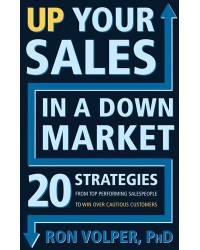
Up Your Sales in a Down Market book cover
Photos: Career Press
As consumer worries continue following the Great Recession and purchases decline the role of sales staff gains importance. Ron Volper, Ph.D., a consultant who has advised 300 companies including 87 Fortune 500 Companies on ways to increase sales, shares his thoughts on how to survive and thrive in the New Economy in Up Your Sales in a Down Market: 20 Strategies From Top Performing Salespeople to Win Over Cautious Customers (Career Press, $15.99), a 224-page softcover book published this year.
Based on 30 years of sales experience and his firm’s proprietary research on the topic Volper is convinced that people in sales need to update their strategies to adjust to customers attitudes and behaviors toward buying. He felt so strongly that he dedicated one year and nine months to publishing the book, his first.
The change in attitudes has had tangible effects on the purchasing process in today’s budget conscious companies, he says in the Introduction. For example, where a single person may have made purchasing decisions in the past a committee may be deciding now; and where a customer may have relied on sales assurances of quality in the past they may require proof today.

Ron Volper, Ph.D., author, Up Your Sales in a Down Market
In the book, he outlines 20 strategies to increase sales and discusses practical skills designed to help sales staff win over cautious customers, orient buyers to overcome fears and objections, prepare presentations to convince hard-to-win-over customers and train sales teams to rely on the winning habits of top-performing salespeople.
“Ask more questions to find out your customers’ needs and expectations,” he said by email in reply to a question asking his advice to novices, nonprofits and small businesses. “Talk less and later in the sales conversation and listen closely to what the customer says and does not say. Once you make a sale do everything you can to stay in touch with your customers and exceed their expectations; for a current customer is 25 times more likely to buy another product (or in the case of a non-profit contribute to your cause) than a new customer is likely to buy anything. And the best way to develop new customer relationships is by getting referrals and introductions from existing customers.”
Volper is managing partner of the Ron Volper Group and an adjunct faculty member at New York University. Before founding his company he was vice president of Sales and Marketing for McGraw-Hill and headed Sales Consulting and Training for Xerox Learning Systems.

Click to buy Up Your Sales in a Down Market
Comments:
Filed Under: Books
Posted by Elena del Valle on February 2, 2012
Information provided by Event Partner
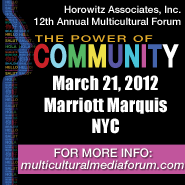
Horowitz Associates, Inc.’s 12th Annual Multicutural Media for Multicultural America Forum
March 21, 2012 | Marriott Marquis Hotel, NYC
7:30 a.m. – 1:00 p.m.
Now in its 12th year, this annual Forum is THE venue for learning about trends that affect and influence your viewers and your audiences—America’s multicultural consumers. Come to the Forum to get the latest research on the attitudes and behaviors of multicultural audiences especially as it applies to pay TV, broadband, and mobile platforms. This Forum has become the signature event where programmers, advertisers, agencies, and pay TV companies discuss strategies for capturing and retaining audiences and subscribers in multicultural America.
Adriana Waterston, Vice President, Marketing & Business Development at Horowitz Associates, will present findings from three Horowitz studies to give attendees a comprehensive, 360° view of multicultural, multiplatform consumers: Viewing the Viewer, an in-home videography of multicultural households; State of Cable and Digital Media: Multicultural Edition, a quantitative survey of multicultural consumers across America; and the Consumer Voice Community, an 8-week online research community focused on the media lifestyles of America’s multicultural consumers and how they are adopting to a rapidly changing media world.
The morning will also include a keynote presentation from a top exec from NBC Universal/Telemundo/mun2; an advertiser panel, The Community of “US,” moderated by 20-year marketing veteran and Principal of Fearless Multicultural Jorge Consuegra; a programming and distribution panel, Staying Tuned with Multicultural America; and the programming showcase, featuring all the best new programming from our sponsors and presented by Melvin Perez, President and CEO of MGM Networks Latin America, who will be showcasing Ella, the new Spanish-language network targeting U.S. Latinas with lifestyle and entertainment programming.
The online research community platform is being provided by Ramius Corporation; for the 8 weeks prior to the event, registrants will be able to log in and follow the community in real-time. For more about the studies and a preview of Viewing the Viewer, please visit: www.multiculturalmediaforum.com/presentation.
Confirmed Speakers
Barry Blyn, Vice President, Consumer Insights, ESPN
Jorge Consuegra, Principal, Fearless Multicultural
Ruben Mendiola, VP and General Manager, Multicultural Video Services, Comcast
Melvin Perez, President and CEO, MGM Networks Latin America
David Saldarriaga, Director, Sales & Marketing, Charter Communications
Adriana Waterston, VP, Marketing & Business Development, Horowitz Associates, Inc.
…and more to be confirmed! Speakers will be posted to www.multiculturalmediaforum.com as they are confirmed, so check back often!
Register early and save—early bird discount $249 (through February 17)!
Enter code HMPR2012 online at www.multiculturalmediaforum.com and receive an extra $50 off!
For more information and sponsorship opportunities, please contact us at 914-834-5999 or adrianaw@horowitzassociates.com.
Posted by Elena del Valle on February 1, 2012
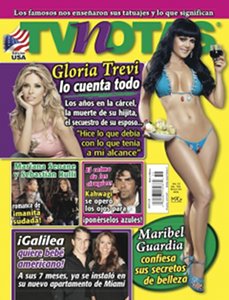
TVNotas USA cover February 2012
Photo: Maya Publishing Group
In 2010, TVNotas USA, a weekly Spanish language editorial gossip magazine launched in 1999 in the United States and sold mainly at newsstands, had a circulation of 150,000. Due to the economic downturn the magazine reduced publication to twice a month (26 issues per year) in November 2010 (see Maya institutes publication changes effective immediately). By 2011, circulation had increased to 220,000 boosting the magazine’s points of distribution nationally.
Sales rose 18 percent between 2010 and 211, marketing staff believe, due in part to the lesser frequency of publication which provided more exposure time, and the added points of distribution. TVNotas USA targets Spanish dominant women 18 to 44 years of age and publishes 1.2 million magazines per year with an estimated reach of 7.9 million thanks to a pass along rate of 6.4. More than 50 percent of the readership is of Mexican origin.

Jusmir Gonzalez, editor, TVNotas USA
The magazine’s 96 interior pages and four cover pages are divided into 70 percent editorial content and 30 percent ads. Editorial, produced in the United States and Mexico, is 57 percent entertainment; 11 percent each celebrity interviews, fashion and beauty, and lifestyle; and 5 percent each food and recipes and other content. Jusmir Gonzalez is the new editor of the magazine.
The magazine also has an online presence, tvnotasusa.com, with frequent updates published by Grupo Editorial Notmusa of Mexico, the parent company of Maya Publishing Group. The website had an audience of one million its first year of operations.
Comments:
Filed Under: Media
Posted by Elena del Valle on January 30, 2012

Angelica Perez, Ph.D., publisher, NewLatina.net
Photo: Angelica Perez, Ph.D.
A podcast interview with Angelica Perez, Ph.D., publisher, NewLatina.net is available in the Podcast Section of Hispanic Marketing & Public Relations, HispanicMPR.com. During the podcast, Angelica discusses New Latinas with Elena del Valle, host of the HispanicMPR.com podcast.
Angelica is a clinical psychologist by profession, with 16 years of experience as a counselor and therapist, anchoring her work on women empowerment. Formerly a research assistant professor at New York University School of Medicine, Angélica is in private practice in New York. She is the first Latina iVoice on iVillage.
To listen to the interview, scroll down until you see “Podcast” on the right hand side, then select “HMPR Angelica Perez, Ph.D.” click on the play button below or download the MP3 file to your iPod or MP3 player to listen on the go, in your car or at home. To download it, click on the arrow of the recording you wish to copy and save it to disk. The podcast will remain listed in the January 2012 section of the podcast archive.
Posted by Elena del Valle on January 27, 2012
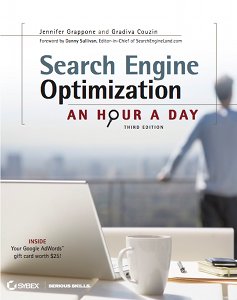
Search Engine Optimization book cover
Photos: Jennifer Grappone, Gradiva Couzin
Jennifer Grappone and Gradiva Couzin make their living as partners of a California search engine optimization and social media consulting company. They dedicated six months to writing a book about what they do for clients. Two updates followed, each one requiring about six months to achieve. In the third and most recent edition of Search Engine Optimization An Hour A Day (Wiley, $29.99), published in 2011, they outline their thoughts on the subject starting with a basic explanation in the first chapter and making their way slowly to the final tenth chapter where they suggest supplemental ideas in Extra Credit and Guilt-Free Slacking. Every section was updated and the authors added more information on social media, online reviews, and local search optimization.
“The tactics laid out in the book can apply to any site, and we have customization tips dedicated to many types of companies, from one-person shops to large B2C or retail sites. We hear from readers in a wide range of industries and organizations large and small, however we think our book is probably most popular with small business owners,” said Couzin by email in response to a question about their target audience. “The book definitely has some readers in the over-50 crowd who might be turned off by more technical books, and we also hear from readers in their 20s who are just getting started in online marketing. We’ve also learned that the book is being used as a textbook for college-level marketing courses, which is exciting!”
Along the way they address large, small and really small companies and their needs in the 408-page softcover book divided into three parts. In Chapter 4, for example, they discuss current search engine procedures and emphasize the importance of building a visitor centered website without obsessing about search engines. Success with search engines and clients remains part science and part art, according to them.

Gradiva Couzin, co-author, Search Engine Optimization
“There is no such thing as ‘set it and forget it’ with SEO and social media.You have to keep updating your site, generating excellent content, building relationships, and trying new strategies to keep ahead of your competitors. This is particularly true with regard to social media, you have to be open to new strategies and constant testing,” said Couzin.

Jennifer Grappone, co-author, Search Engine Optimization
In the book, the authors point out what they consider the most important factors that may lead to high search engine placement: incoming links and link text, the standing of the site, the title of the page in HTML code, HTML text visible on a page, how old a domain is, being the first publisher of the content and having fresh content or updates and the loading speed of the site.
They also discuss search ranking factors, paying for placement, and trend spotting. Other chapters address the importance of team work, a monthlong plan for three months, and options to lower the workload while maximizing results.
Before turning her efforts to search engines in 2000 Grappone was a web project manager and video producer. Couzin, a civil engineer and programmer, started working with search engine optimization a year before her colleague.

Click to buy Search Engine Optimization (SEO)
Comments:
Filed Under: Books





























